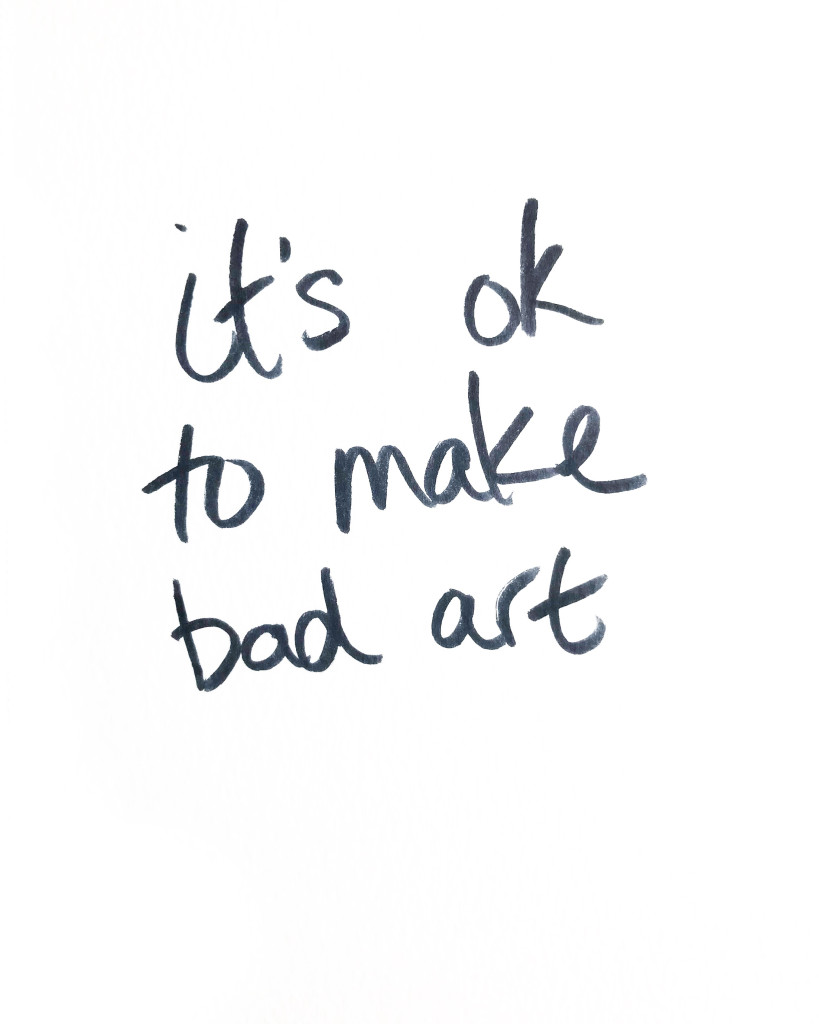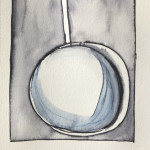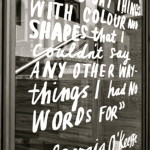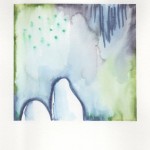
After I posted this image to my painting Instagram the other day, it sparked quite a discussion. But I still wanted to share it here, because I do stand by this statement and it’s importance in the art making process. (And really, the process of learning anything new or taking up something we did once, but haven’t done in a long time.)
As I’ve been getting back into painting, there are times when I’ve found myself paralyzed before starting. (Especially on days when I’m not really sure what I want to paint.) But I also know that the key to getting better at anything is to do it and do it often. Which is why I decided to adopt this mantra: it’s ok to make bad art.
Interestingly, the response (as I alluded to above) was mixed. For some, they saw it as clear permission to simply make, without regards to the outcome. For others, the use of the word bad constituted something negative to be avoided.
Now, I want to be clear about my use of the word bad. This isn’t a judgement I apply at the end of a painting. It’s a mindset I use at the beginning. Perhaps a more apt way to describe it is telling myself “you don’t have to make a masterpiece” every time I start painting.
Which brings up a question from the comments, why not just say, “it’s ok to make art.”
Because I also know how heavy and loaded the word Art can be, which is why I think giving ourselves permission to do it badly is so important. Because for many people, the idea of making art alone is as equally paralyzing as trying to make good art. (Or trying not to make bad art.)
And while I know that historically, good or bad are judgements made by a select few (mostly white males), that’s not the scale I’m judging it on. I simply think of good or bad as art that achieves the intent of the person creating it. (In this case, me.)
So I’m standing by use of the word bad. Not just that, but I’m defending it. Because I think giving yourself permission to make bad art is an important part of the learning process.
First, giving yourself permission to make bad art acknowledges that art is a skill that can be improved upon. And the more you do it, ideally, the better you’ll get. Of course, we all know that growth in any skill isn’t linear, and some days your results will be better than others. Which is why giving yourself permission to make bad art is important. It acknowledges that you don’t have to try to beat yesterday in order to do the work.
Second, it helps you get over the fear of starting.
And I mean this on so many levels. For me, permission to make bad art gets me over the fear of the blank page or the blank canvas. It is literally the call I need to make art on days when I’m just not feeling it.
But giving yourself permission to make bad art can also help anyone who wants to learn art (in any form, from painting to drawing to metalsmithing to fibers, etc.) get over the fear of starting. When you acknowledge that not only might you be bad in the beginning, but that it’s OK to be bad, you release the fear that’s holding you back from trying.
The same holds true for those of us who made art once upon a time in our lives, and are now trying to get back into it. Giving yourself permission to make bad art means you don’t have to try to live up to the artist you imagined you were back in the day. (Or, for those of us that went to art school, to live up to the standards that have been foisted upon us there.)
For too many years, we’ve been taught to believe that making art only belongs to a chosen few. But imagine if the only people who ever ran were professional runners. Or the only people who ever cooked food were gourmet chefs. Permission to make bad art opens art up to so many people who want to try, but have felt like they’d never be good enough.
Permission to make bad art also keeps you from treating anything as too precious. It gets you over the hump of starting, but it also allows you to push and experiment past a certain point on any given piece. Permission to make bad art can help us push past making safe art, the art that we know isn’t really done, but that we’re worried we’ll destroy if we push it further.
And finally, I think giving ourselves permission to make bad art is so important because it’s what allows us to find our own voice and style. (And this is the idea that really prompted me to post this to Instagram in the first place, inspired by this post from Raven Roxanne.) This is especially important in an age of Instagram, where we’re trained to do things for the likes. But trying to make art just to get likes (or growth) is dangerous, especially when it leads to copying another person’s style.
Permission to make bad art means that you aren’t motivated by social media accolades, which means you can worry about making your own work, not anyone else’s. And for me, that’s really the crux of giving permission to make bad art. While I have some ideas about the kind of work I want to make, I’m not entirely sure where my work is headed. And that means I need to give myself the freedom to mess around and mess up as I build my skills and my style.
And for me, that’s why “It’s ok to make bad art” is such an important mantra, especially now, as I’m just finding my way back to painting.




Leave a Reply